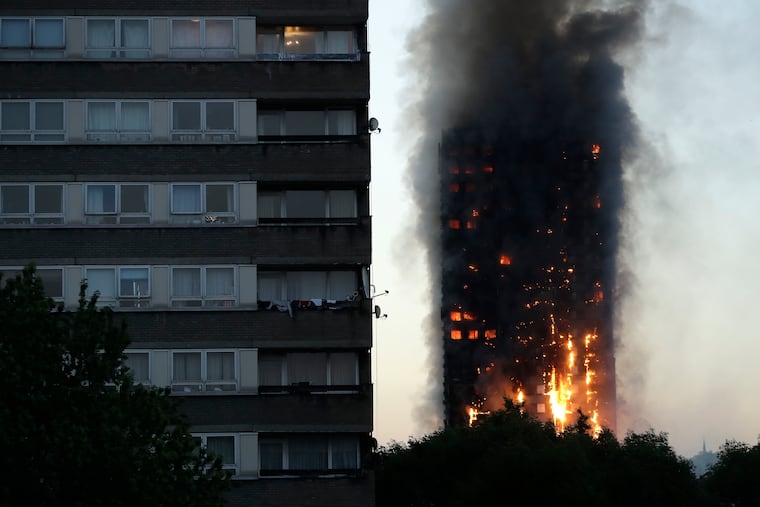London high-rise inferno that killed 72 people blamed on Pa. companies in Philly lawsuit
Flammable materials used to clad a high-rise fueled the 2017 blaze that tore through London’s Grenfell Tower, turning it into a “flaming coffin,” according to a new lawsuit.

Flammable building materials used to clad a high-rise fueled the 2017 blaze that tore through London’s Grenfell Tower, turning the residential complex into a “flaming coffin” for the 72 people who died, according to a lawsuit filed Tuesday in Philadelphia against three American companies.
Philadelphia attorney Robert J. Mongeluzzi, who has in the past won multimillion-dollar settlements, filed the suit on behalf of nearly 250 survivors and families of the victims.
Named as defendants are the cladding fabricator Arconic Inc. of Pittsburgh (formerly Alcoa Inc.), insulation maker Celotex Corp. of Malvern, and Michigan-based Whirlpool Corp., the manufacturer of the Hotpoint brand refrigerator, which local investigators said sparked the deadly inferno.
The suit, which was filed in Philadelphia Court of Common Pleas, does not specifically seek monetary damages. A jury will be called on to determine what penalty, if any, the defendants will have to pay.
The fire — which raged for 60 hours before it was extinguished — broke out in the early morning hours of June 14, 2017, on the fourth floor of the 23-story building in London’s working-class neighborhood of North Kensington. In 12 minutes, the blaze raced skyward to the 19th floor, trapping many of the building’s 600 sleeping residents within.
Fire safety engineers were stunned at how rapidly the fire spread, engulfing the building in less than an hour and preventing firefighters from reaching many people inside. Some jumped to their deaths rather than face the flames, and witnesses reported seeing small children thrown from the tower by their families in a desperate bid for survival.
A Grenfell tenant group had complained for years about the risk of a fire in the building, which was owned by the local government in the borough of Kensington and Chelsea.
The high-rise had undergone an $11 million renovation in 2016 to replace the windows and improve the thermal efficiency of the tower. According to the Telegraph of London, residents accused workers of cutting corners and refused to allow them to enter their flats.
To save £5,000 (about $6,400), building management opted for Arconic’s cheaper Reynobond PE cladding, the London newspaper reported.
Under European standards, the cheaper cladding was considered a combustible material. Despite the knowledge and what the suit describes as “an act of pure corporate greed,” Arconic supplied the cladding to the tower.
“The Arconic cladding and the Celotex could have been made flame retardant,” said Mongeluzzi, of Saltz, Mongeluzzi, Barrett & Bendesky, in an interview with The Inquirer. “These defective materials burned like gasoline and accelerated the flames."
Because it was known to be highly flammable, the polyethylene cladding used to sheath the West London building had been banned in the United States for residential structures taller than 40 feet.
The Grenfell Tower reached a height of 220 feet.
Twelve days after the conflagration, Arconic declared it would no longer sell the cladding for use in residential towers, Mongeluzzi said.
A spokesperson for Arconic said the company “will respond to this litigation in court.”
“We express our deepest sympathy to all those affected by the 2017 Grenfell Tower fire and remain committed to supporting the public inquiry and investigations by the authorities in the UK,” said Arconic’s Rebecca Kral in an emailed statement.
Cyanide gas was purportedly released as the Celotex insulation burned. The fumes killed several people and caused lasting injuries in many of the survivors, said cocounsel Jeffrey Goodman of SMBB.
Celotex, which also withdrew its product from the market after the fire, told the BBC it was “considering its position” following the legal action.
Cocounsel Mark DiCello, of Cleveland-based DiCello Levitt, estimated that the discovery process and interview could require more than 2½ years before the case is heard in court.
One of the London victims issued a statement as the suit was filed in Philadelphia.
“I lived very happily with my wife and two young daughters on the 21st floor of the 23-floor tower. The fire took everything from us, " said Marcio Gomes, 39, who wrapped his family in wet towels and led them out of the roaring inferno.
“My wife was 7-months pregnant when the smoke and cyanide killed our son before he was born into this world. It was all completely avoidable,” Gomes said. “It should never have happened. It should never happen again to anyone, anywhere, anytime.”
The Associated Press contributed to this report.